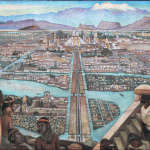
The opposite of sunna, first in pre-Islamic Arabia and ultimately within Islam itself, was bid‘a (“innovation”), which eventually came to mean “heresy” Thus, the Islamic community became a conservative one in which “heresy” was divergence from the established practice of the community. (It might be seen why one sect of Islam claimed for itself the title of Sunni. They were calling themselves orthodox—and, not accidentally, implying that those who disagreed with them were heretics.)
Again in keeping with the practice of Arabs before Islam, information about the Prophet’s customary behavior, his sunna, was passed down in the form of hadith, or, as they are commonly (if somewhat misleadingly) called in English, “traditions.”[1] These were generally short narrations—anecdotes, really—originally told by one of the “companions” or associates of the Prophet and passed down by a chain of scholars, or at least by a series of pious Muslims, who served as transmitters.
A typical example of the hadith comes from the standard, almost canonical, collection of al-Bukhari.[2] “It was told us,” records al-Bukhari,
by Abdullah ibn Yusuf who said, it was told us by al-Layth, who had it from Yazid, who had it from Abu al-Khayr, who had it from Uqba ibn Amir, who said, “Someone sent the Prophet a silk gown and he wore it during the prayers, but on withdrawing he pulled it off violently with a gesture of disgust and said ‘This is unfitting for God-fearing men.’[3]
It was on material like this that later generations of Muslim thinkers, very much in the manner of the classical rabbis, would exercise their skills of analysis. What did the anecdote mean? Was the Prophet saying that silk gowns were too ostentatious, too foreign to the simplicity that ought to characterize a man of God? Was it the silk fabric of the garment to which the Prophet had objected? Or was it, rather, the cut of the garment? Muhammad wore the gown during prayer; only afterward did he take it off. Did he receive some sort of divine guidance while he was praying? When, and how, did he decide that the garment was inappropriate? Are elegant clothes appropriate for prayer and worship, but not for a Muslim’s everyday life? Those who studied the hadith reports about the Prophet and his companions often subjected the traditions to minute interrogation and rigorous reflection.
[1] The Arabic word hadith is pronounced hah-DEETH. Strictly speaking, it is singular. I will follow common English usage, however, and regard it as both singular and plural, depending on the context. The preference among many Western scholars today is to use the term hadith rather than traditions.
[2] Pronounced Boo-KHAR-ee.
[3] This hadith is cited, in fragmentary form, by H. A. R. Gibb, in his Mohammedanism (London: Oxford University Press, 1970), 51-52. I have modified the translation slightly.












